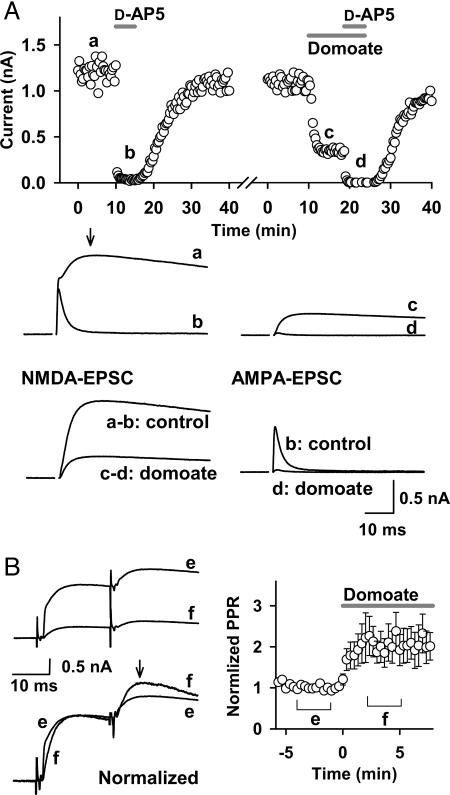Fig. 1.
The AMPA/kainate receptor agonist domoate presynaptically attenuates EPSCs. (A) Amplitudes of NMDA-EPSCs (ordinate) deduced from the peak amplitude of a slow component of EPSCs (at 10 -15 ms from the onset, arrow in trace a) evoked at a holding potential of +40 mV. d-AP5 (50 μM) abolished this component (trace b). Domoate (10 μM) attenuated EPSCs (trace c). d-AP5 abolished the remaining component in the presence of domoate (trace d). Sample traces show NMDA components and AMPA components of EPSCs, the former being obtained by subtracting the d-AP5-resitant (AMPA) component before (a and b) and during (c and d) domoate application (superimposed). Both NMDA (a - b) and AMPA (b) components of EPSCs were attenuated by domoate (c - d and d). Input resistance of MNTB neurons was 29.8 ± 3.2 MΩ and 23.4 ± 1.9 MΩ (at +40 mV, n = 4) before and during domoate application, respectively. (B) EPSCs evoked by the paired-pulse stimulation (interpulse interval, 20 ms) at +40 mV before and during domoate application (superimposed in traces). (Left) EPSCs before (trace e) and during (trace f) domoate applications are superimposed with (Lower) or without (Upper) normalization at the first amplitude. Slowing in the rise time of EPSCs during domoate application (first EPSCs in the normalized and superimposed trace) is consistent with the stronger inhibitory effect of domoate on AMPA-EPSCs. (Right) Time plot of paired-pulse ratios (PPRs) normalized to the control value (mean of 10 points before domoate application). The arrow indicates the point at which the second EPSC amplitude was measured. Data points and error bars during domoate application (bar) indicate mean values and SEMs of PPRs relative to control.

